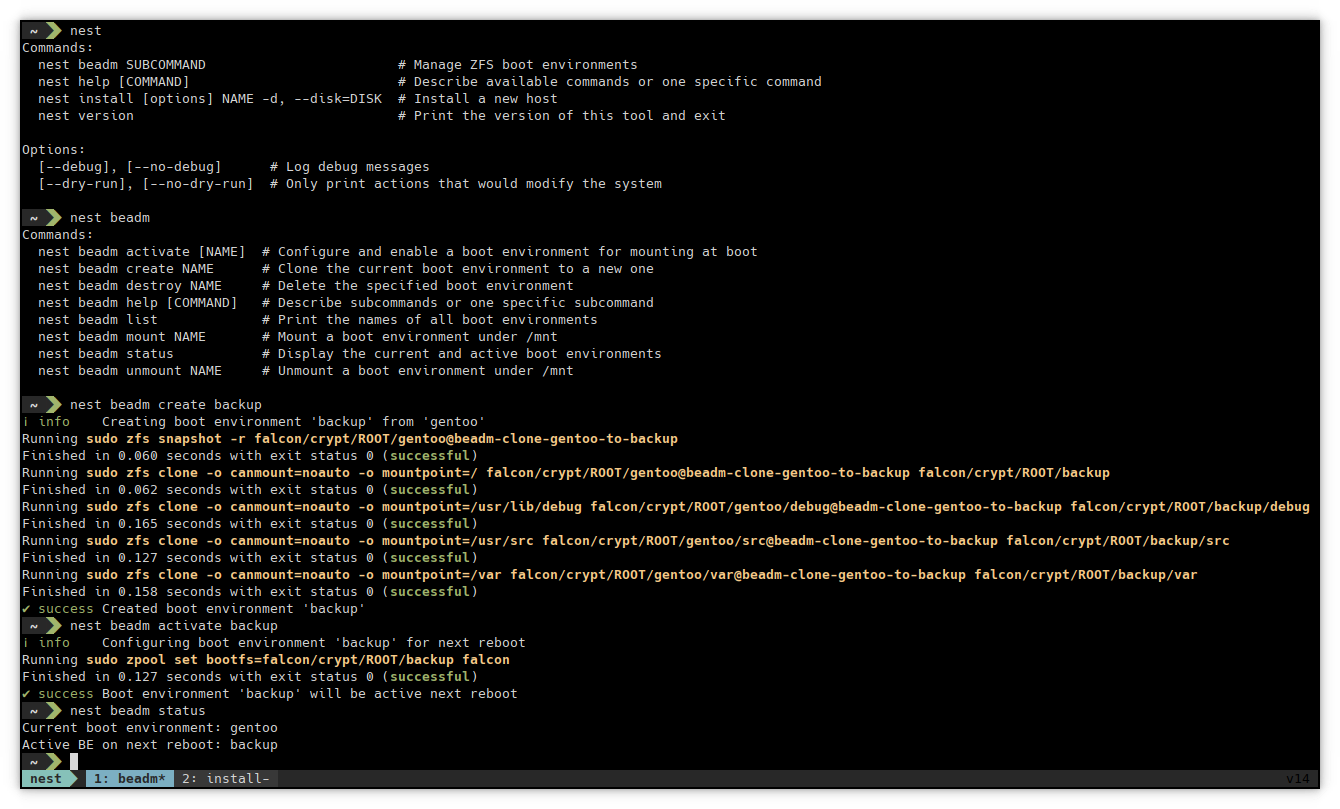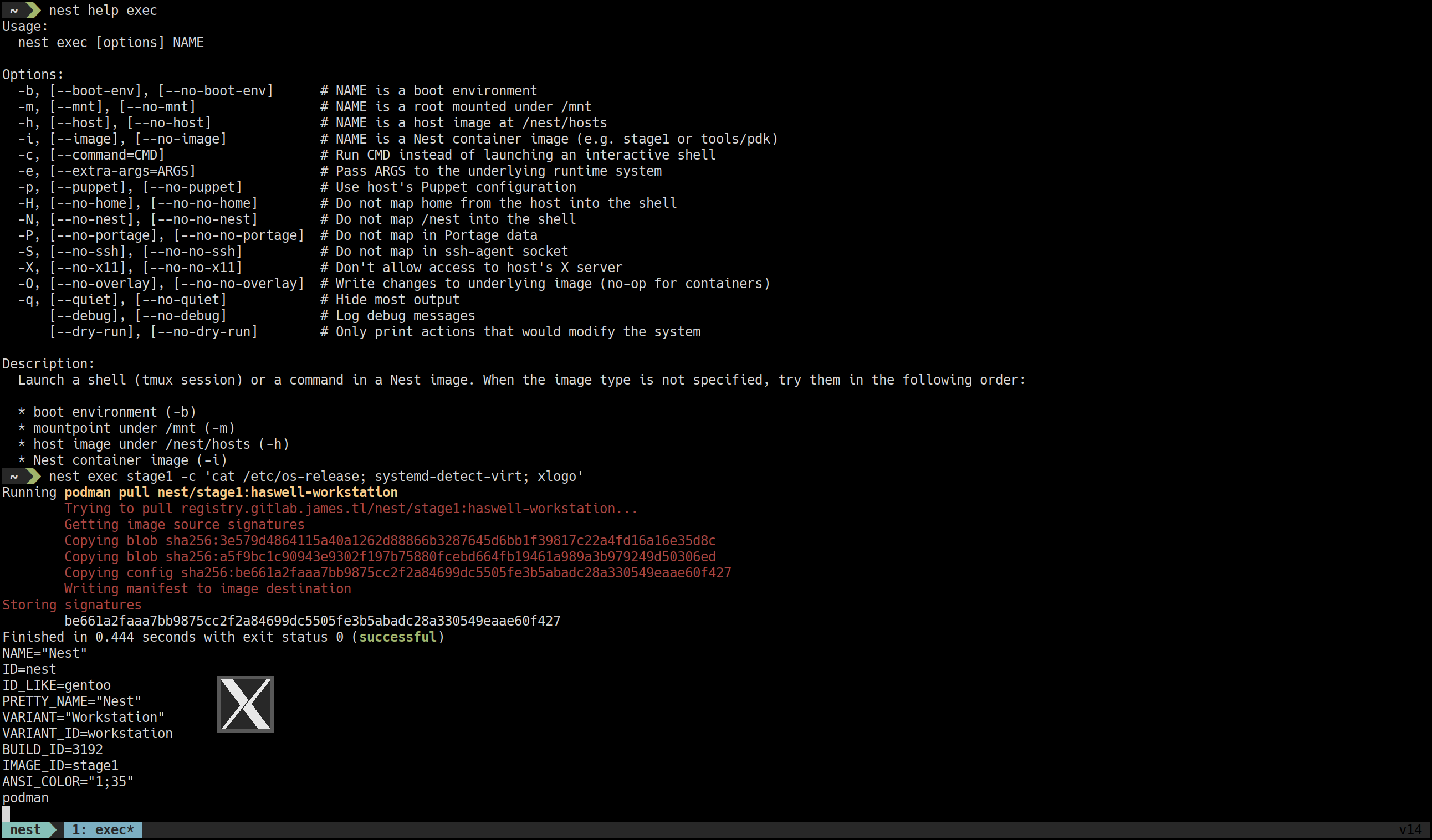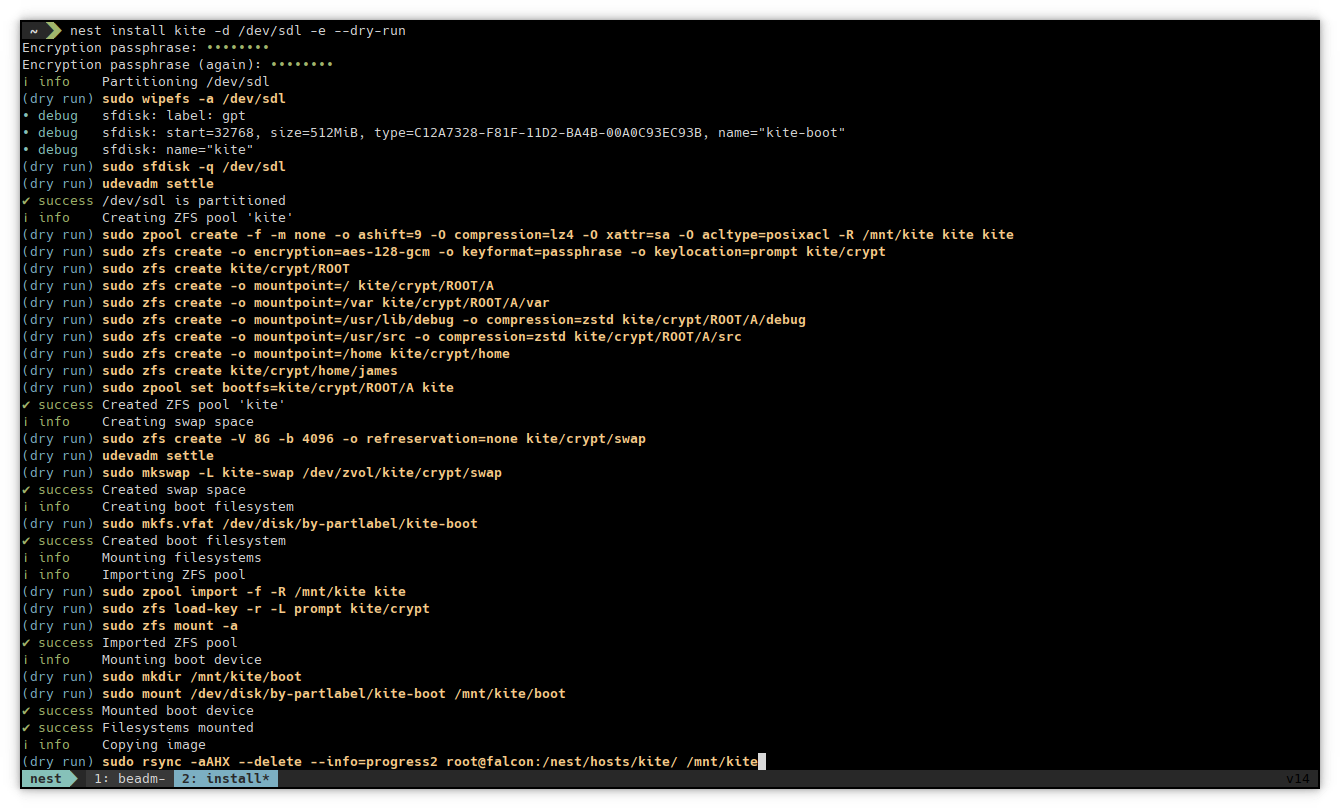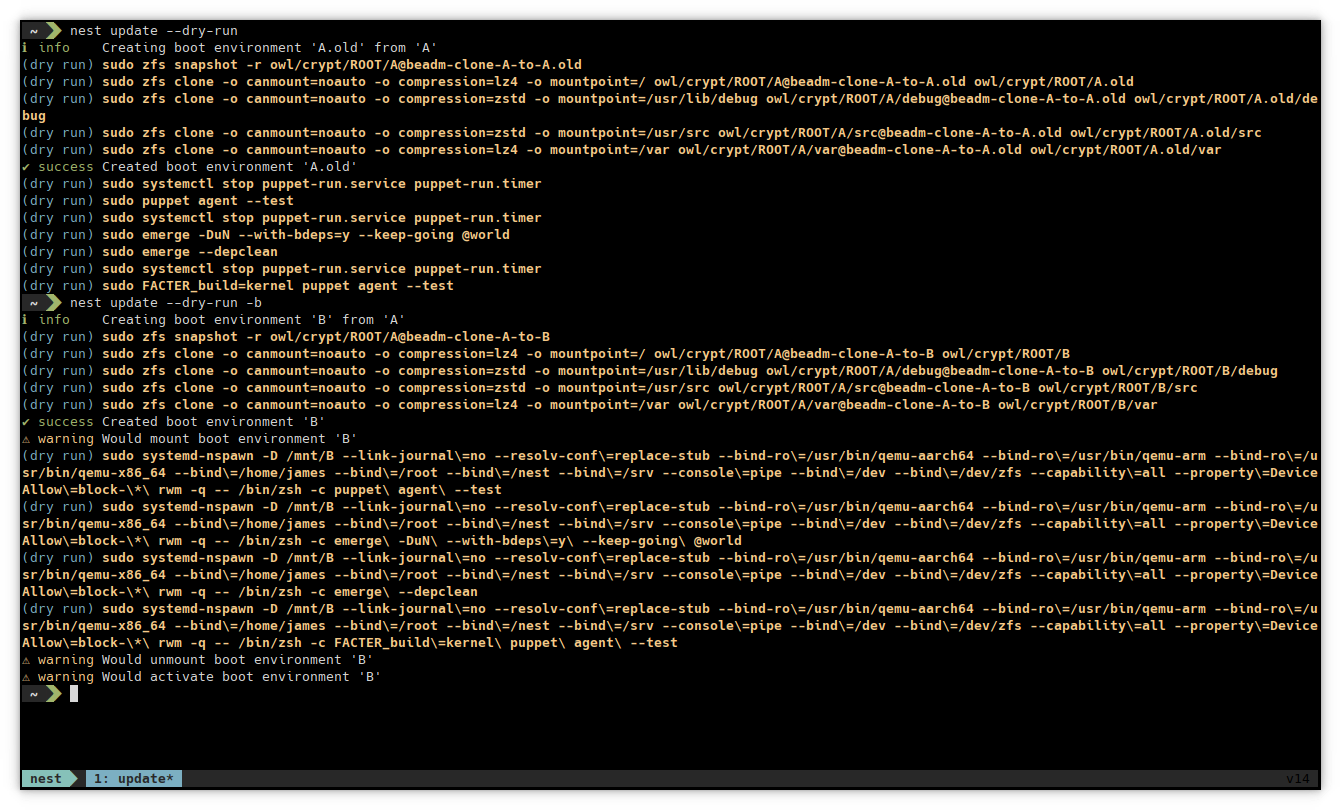This is a collection of commands written in Ruby to install, update, and generally administer the Nest distribution.
Puppet
ensures the latest app-admin/nest-cli package from the Nest
overlay
is installed.
All commands provided by this program can be accessed by running nest. There
are subcommands to manage ZFS boot environments, install new hosts, update
existing hosts, and reset them back to the desired state.
| Commands | Description |
|---|---|
nest beadm SUBCOMMAND |
Manage ZFS boot environments |
nest exec NAME |
Run a command in a Nest image |
nest install NAME |
Install a new host |
nest update |
Update hosts and images |
nest beadm provides subcommands to create, destroy, mount, unmount, activate,
and query ZFS boot environments, which are clones of the OS filesystems
inspired by the same concept in Solaris
11. Boot
environments are used by the Nest installer to perform A/B seamless system
updates similar to Android.
| Commands | Description |
|---|---|
nest beadm activate [NAME] |
Configure and enable a boot environment for mounting at boot |
nest beadm create NAME |
Clone the current boot environment to a new one |
nest beadm destroy NAME |
Delete the specified boot environment |
nest beadm list |
Print the names of all boot environments |
nest beadm mount NAME |
Mount a boot environment under /mnt |
nest beadm unmount NAME |
Unmount a boot environment under /mnt |
nest beadm status |
Display the current and active boot environments |
All of these commands accept a --dry-run argument to only print the changes
that would be made.
nest exec launches a command or shell (tmux session) inside of a Nest image
using either Podman or systemd-nspawn as appropriate. It provides a uniform
interface for getting into boot environments, root disks mounted under /mnt,
host images from /nest/hosts, and Nest container images, regardless of
architecture. It maps in useful host data, such as Portage, by default.
| Options | Description |
|---|---|
-b, --boot-env |
The specified NAME is a boot environment |
-m, --mnt |
The specified NAME is a root mounted under /mnt |
-h, --host |
The specified NAME is a host image under /nest/hosts |
-i, --image |
The specified NAME is a Nest container image (e.g. stage1) |
-c, --command=CMD |
Run CMD instead of launching an interactive shell |
-e, --extra-args=ARGS |
Pass ARGS to the underlying runtime system |
-p, --puppet |
Map host's Puppet configuration into container |
-H, --no-home |
Do not map homes from the host into the container |
-N, --no-nest |
Do not map /nest into the container |
-P, --no-portage |
Do not map Portage data into the container |
-S, --no-ssh |
Do not map ssh-agent socket into the container |
-X, --no-x11 |
Do not allow access to the host's X server |
-O, --no-overlay |
Write changes to the underlying image (no-op for boot environments and container images) |
-q, --quiet |
Hide most output (except output produced by the command or shell) |
--debug |
Show debug messages (there isn't any meaningful debug output yet) |
--dry-run |
Only print actions that would modify the system |
When the image type (-b, -m, -h, -i) isn't specified, they are tried in
that order.
nest install is the Nest installer for hosts with a Stage
3 image. It understands everything from
partitioning to firmware installation and provides reasonable fault tolerance.
| Options | Description |
|---|---|
--clean |
Just run the cleanup step |
-b DISK, --boot=DISK |
Optional boot disk to use. Enables whole disk zpool support. |
-d DISK, --disk=DISK |
The disk to format and install on (e.g. /dev/sda or /tmp/boot.iso) |
-e, --encrypt |
Use ZFS encryption |
--force |
Run cleanup actions (like umount) to try to correct unexpected system states |
-s STEP, --step=STEP |
Only run this installation step |
--begin=STEP |
The first installation step to run (default: partition) |
--end=STEP |
The last installation step to run (default: firmware) |
--ashift=SIZE |
Set the zpool ashift value (default: 9) |
--debug |
Print additional information, such as the input provided to commands |
--dry-run |
Only print actions that would modify the system |
The steps are self explanatory and, unless specified with --step, --begin,
or --end options, run in the following order:
partitionformatmountcopybootloaderunmountfirmwarecleanup(not run by default)
nest update performs a traditional package-based update with backups and
configuration management.
| Options | Description |
|---|---|
-b, --boot-env |
Update the alternate boot environment |
-d DIR, --dir=DIR |
Update the image mounted at DIR |
-e ARGS, --extra-args=ARGS |
Pass ARGS to the emerge update command |
-r, --resume |
Skip the backup step |
-s STEP, --step=STEP |
Only run this update step |
--begin=STEP |
The first update step to run (default: backup) |
--end=STEP |
The last update step to run (default: activate) |
-n, --noop |
Run Puppet and Portage commands in no-op mode |
-v, --verbose |
Run Portage commands with extra verbosity |
-q, --quiet |
Hide most output (except output produced by the command or shell) |
--debug |
Print additional information, such as the input provided to commands |
--dry-run |
Only print actions that would modify the system |
The steps are self explanatory and, unless specified with --step, --begin,
or --end options, run in the following order:
backupmountconfigpre(if/etc/nest/pre-update.shexists)packagespost(if/etc/nest/post-update.shexists)reconfigunmountactivate
nest reset resets this host from its Stage 3 image.
| Options | Description |
|---|---|
-k, --kernel |
Just update the kernel |
-f, --firmware |
Just update the firmware |
-r, --resume |
Skip the backup step |
-s STEP, --step=STEP |
Only run this update step |
--begin=STEP |
The first update step to run (default: backup) |
--end=STEP |
The last update step to run (default: activate) |
-n, --noop |
Run Puppet and Portage commands in no-op mode |
-v, --verbose |
Run Portage commands with extra verbosity |
-q, --quiet |
Hide most output (except output produced by the command or shell) |
--debug |
Print additional information, such as the input provided to commands |
--dry-run |
Only print actions that would modify the system |
-t, --test |
Test rsync with checksums instead of times |
The steps are self explanatory and, unless specified with --step, --begin,
or --end options, run in the following order:
backupmountsynckernelunmountactivatefirmware(not run by default)
This program is developed with Bundler. Initialize the project with bundle install, then make changes to code under the lib directory. Check the code
with bundle exec rake and run the CLI with bundle exec bin/nest.
Prepare for release by bumping VERSION in lib/nest/version.rb and create a
new Git tag followed by a new GitLab
release.



